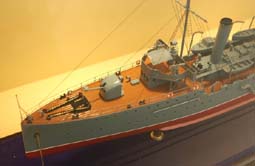
|
| Sail to scale: A model of the Zhong Shan Gunboat on display at the Museum of Coastal Defence. |
The Zhong Shan Gunboat played an important role in Chinese history, helping Dr Sun Yat-sen shape modern China.
Here is a brief history of the gunboat that was originally named the Yong Feng.
The Qing court ordered the Yong Feng gunship from Japan in 1910 to strengthen her navy. It sailed to Shanghai to start service in March 1913.
In July 1917, it sailed to Guangzhou to join Dr Sun who initiated a campaign to fight northern warlords and protect the parliament and the constitution.
In 1922, the Guangdong warlord Chen Jiongming led a mutiny against Sun who then used Yong Feng to lead his fleet to break the blockade.
The gunboat barely escaped from destruction. Dr Sun and his comrades departed Yong Feng and were escorted by a British gunboat to Hong Kong, where they boarded a liner to Shanghai.
In November 1924, Sun and his wife, Soong Qingling, boarded Yong Feng again and left Guangzhou for Beijing via Hong Kong.
Following Dr Sun's death in March 1925, Yong Feng was renamed Zhong Shan in recognition of Sun's contribution to China.
It was sunk in October 1938 by Japanese fighter planes during China's war of resistance against Japan.
In commemoration of Dr Sun and the personnel who died in the fight against Japan, the Hubei Provincial Cultural Bureau drew up a plan in 1986 to salvage the Zhong Shan.
The gunboat was eventually recovered from the Changjiang River bottom in 1997, and more than 3,400 relics were found.
The gunboat was restored to its initial appearance in 2001, while preserving some traces of damage caused by the Japanese fighters.
The Zhong Shan Gunboat Museum will become the first floating museum in China when a floating dock tailor-made for the vessel, now under construction, is completed.
|